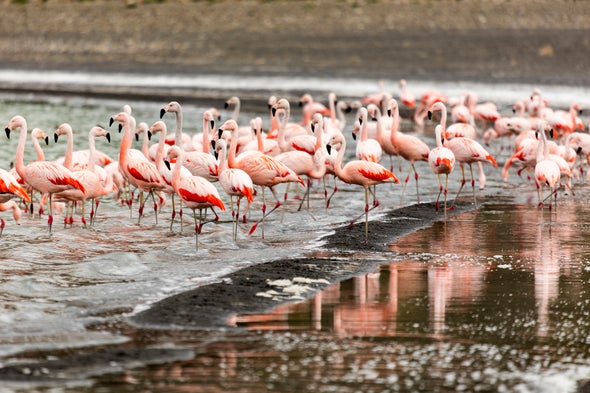(单词翻译:单击)
听力文本
This is Scientific American's 60-second Science. I'm Jason Goldman.
Spend some time watching flamingos, and you might think that not much goes on in their tiny heads. But these elegant avians actually lead complex social lives. Each bird has certain other individuals it prefers to spend time with and others it avoids. In other words, flamingos have friends.
The Wildfowl and Wetlands Trust, the WWT, manages a number of wetlands in the U.K., some of which have communities of captive aquatic birds, including flamingos.
"They didn't quite know whether they could just take a flamingo out of the environment and stick it in a new flock, and it would be fine. Or should they care a bit more about the social choices that the birds were making?"
Paul Rose, a psychologist at the University of Exeter's Center for Research in Animal Behavior.
For five years, Rose and his team observed the daily goings-on of five of the world's six different flamingo species, housed at the WWT Slimbridge Wetland Center in Gloucestershire. The five species are the Chilean, Andean, American, James's and lesser flamingos.
"The partnerships that we see between birds are nonrandom. The birds are choosing who to associate with."

Male-female pairs spend time together, but so do same-sex pairs and even groups of three or four. And those relationships can last for many years. The findings are in the journal Behavioural Processes.
"So there were some flamingos in the group that really didn't care who their partner was for that day. They would flit around, and they would have many different relationships with many different birds."
And of course, there were other flamingos that were less social butterfly and more lone wolf. But even they had a few close friends.
"Those birds that were least gregarious had more investment in a smaller number of social bonds with flamingos that they knew really well."
Rose thinks that flamingos may have evolved their social lives due to their wetland habitats—in which the resources they need are concentrated in a small area.
"The social organization is layered on top of this need to be in one environment, so you have to be gregarious. If flamingos know their partners—if they know that these six birds, say, are friendly, and they get on with them—they can then waste less energy scrapping and squabbling with other birds that they don't get on with."
By spending time with their friends, flamingos can more efficiently direct their limited time and energy to activities like foraging and mating.
"If I want to go stand on one leg and preen my feathers, I'll go and stand on my leg and preen my feathers next to Fiona, because I get on with her, rather than next to Frank, because I hate him, and we'll just scrap."
If all this sounds familiar, well, we all know a Fiona—as well as a Frank.
Thanks for listening for Scientific American's 60-second Science. I'm Jason Goldman.
参考译文
这里是科学美国人——60秒科学。我是杰森·古德曼。
花点时间观察火烈鸟,你可能会认为它们的小脑袋里没想太多东西。但这些优雅的鸟实际上过着复杂的社交生活。每只鸟都有愿意与之共度时光和想躲开的同类。换句话说,火烈鸟是有朋友的。
英国野生鸟类和湿地基金会(简称WWT)负责管理英国的多个湿地,其中一些湿地有包括火烈鸟在内的圈养水鸟群。
“他们不太清楚是否可以直接将火烈鸟从环境中带出来,然后放到一个新群体中就行了。还是他们应该多关心一下这些鸟的社交选择?”
埃克塞特大学动物行为研究中心的心理学家保罗·罗斯说到。
五年来,罗斯及其团队观察了安置在格洛斯特郡斯林布里奇湿地中心的全球六种火烈鸟中五种的日常活动。这五种火烈鸟分别是智利火烈鸟,安第斯火烈鸟,美洲火烈鸟,詹姆斯火烈鸟和小火烈鸟。
“我们观察到,火烈鸟之间的伙伴关系并非是随机的。它们在选择与谁来往。”
雌雄鸟会在一起,但同性鸟伴侣甚至由三四只鸟组成的小群体也会聚集在一起。这些关系可以持续很多年。这项研究结果发表在《行为过程》期刊上。
“团体中有些火烈鸟真的不在意那天的伙伴是谁。它们会飞来飞去,还会与许多同类建立许多不同的关系。”
当然,也有些火烈鸟不太喜欢社交,更喜欢独来独往。但这些鸟也有几个亲密朋友。
“那些最不爱社交的火烈鸟,在数量较少而且是它们极为熟悉的同类组成的社交联系中会投入更多。”
罗斯认为火烈鸟可能因湿地栖息地而进化出社交生活,因为在湿地中,它们需要的资源都集中在一小块区域。
“社会组织是分层的,而且需要处于一个环境中,因此你必须群居。如果火烈鸟认识伙伴,如果它们认识6只友好且能相处融洽的同类,那它们就可以少浪费精力与相处不来的同类吵架和争斗。”
通过和朋友在一起,火烈鸟可以更有效地将有限的时间和精力用于觅食和交配等活动。
“如果我想单腿站立并梳毛,我会在菲奥娜旁边这样做,因为我和她相处得很好,我不会在弗兰克旁边这样做,因为我讨厌他,一见面就会打架。”
如果这一切听起来很耳熟,那我们都认识菲奥娜和弗兰克。
谢谢大家收听科学美国人——60秒科学。我是杰森·古德曼。
译文为可可英语翻译,未经授权请勿转载!
重点讲解
重点讲解:
1. prefer to do sth. 更喜欢;
I prefer to work to a deadline.
我喜欢按规定的期限完成工作。
2. care about 关心;在乎;在意;
Joe Sixpack doesn't care about that.
普通工人不在意那事。
3. on top of 另外;加之;除…之外(还);
An extra 700 jobs are being cut on top of the 2,000 that were lost last year.
除了去年被裁掉的2,000个职位,还有700个岗位在裁撤中。
4. get on with (同…)和睦相处;
She found it difficult to get on with her, possibly because of the difference in their ages.
她觉得很难与她相处,这可能是因为她们年龄上的差距。


